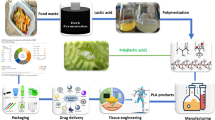Abstract
Films made from microbial polyesters polyhydroxybutyrate (PHB) and poly(hydroxybutyrate-co-hydroxyhexanoate) (PHBHHx) were treated by lipases and NaOH solution. The change of the polyester biocompatibility was evaluated by inoculating mouse fibroblast cell line L929 on films of PHB, PHBHHx and their blends. Polylactic acid (PLA) was used as a control. It was found that untreated PHB and PLA films gave a poor support to the growth of L929 cells, viable cell density ranged from 0.1×104 to 0.7×104 per ml only. While films of pure PHBHHx and PHB blended with PHBHHx showed improved biocompatibility, viable cell density observed increased from 9.6×102 to 6×104 on blended films of PHB/PHBHHx in ratios of 0.9/0.1 to 0/1, respectively. This result showed PHBHHx has a better biocompatibility compared with PHB. Films of PHB, PLA and the blends treated with lipases and 1 N NaOH, respectively, showed an improved ability to support cell growth. Biocompatibility of PHB was approximately the same as PLA after the treatment, while PHBHHx and its dominant blends showed improved biocompatibility compared with PLA. The sensitivity of the treatments was reduced when PHBHHx content increased in the PHB/PHBHHx blends. All three lipase treatments demonstrated more biocompatibility increase on all the films compared with the results of NaOH treatment. Scanning electron microscopy showed that PHB films changed its surface from multi-porous to rough non-porous after the lipase or NaOH treatment. While PHBHHx films showed little change after these treatments. The results showed that the polyester surface morphology played an important role in affecting cell attachment and growth on these materials.
Similar content being viewed by others
References
A. J. Anderson and E. A. Dawes, Microbiol Rev. 54 (1990) 450.
A. Steinbuchel, in “Biomaterials: Novel Materials from Biological Sources”, edited by D. Byrom (Stockton, New York, 1991) p. 124.
G. Q. Ghen, K. H. Konig and R. M. Lafferty, Antonie van Leewenhock 60 (1991) 61.
D. Byrom, FEMS Microbiol Rev. 113 (1992) 247.
G. Q. Chen and W. J. Page, Biotechnol Biotechnique 11 (1997) 347.
C. Doyle, E. T. Tanner and W. Bonfield, Biomaterials 12 (1991) 841.
J. C. Knowles, G. W. Hastings, H. Ohta, S. Niwa and N. Boeree, ibid. 13 (1992) 491.
F. W. Simon, D. P. Martin, D. M. Horowitz and O. P. Peoples, Intl. J. Biol. Macromolecules 25 (1999) 111.
D. M. Zhang, F. Z. Cui, Z. S. Luo, Y. B. Lin, K. Zhao and G. Q. Chen, Surf. Coat. Technol. 131 (2000) 1-5.
S. Akntar, in “Physiochemical properties of bacterial P(HB-HV) polyesters and their uses in drug delivery”, PhD Thesis, University of Bath (1990).
Y. Doi, S. Kitamura and H. Abe, Macromolecules 28 (1995) 4822.
J. H. Liu, H. L. Jen and Y. C. Chung, J. Appl. Polym. Sci. 74 (1999) 2947.
J. Sacristan, H. Reinecke and C. Mijangos, Polymer 41 (2000) 5577.
G. Zund, Q. Ye, S. P. Hoerstrup, A. Shoeberlein, A. C. Schmid, J. Grunenfelder, P. Vogt and M. Turina, Eur. J. Cardio-thoracic Surgery 15 (1999) 519.
G. Ciapetti, E. Cenni, L. Pratelli and A. Piaaoferrato, Biomaterials 14 (1993) 359.
Y. Marois, R. Guidoin, R. Roy, T. Vidovsky, B. Jakubiec, M. Sigot-Luzard, J. Braybrook, Y. Mehri, G. Laroche and M. King, ibid. 17 (1996) 1835.
D. Sgouras and R. Duncan, J. Mater. Sci.: Mater in Med. 1 (1990) 61.
B. Saad, P. Neuenschwander, G. K. Uhlschmid and U. W. Suter, Intl. J. Biol. Macromolecules 25 (1999) 293.
J. Zhao and G. Geuskens, Eur. Polym. J. 35 (1999) 2115.
T. Furukawa, Y. Matsusue, T. Yasunaga, Y. Shikinami, M. Okuno and T. Nakamura, Biomaterials 21 (2000) 889.
D. J. Chanvel-Lesart, P. Pellen-Mussi, P. Auroy and M. Bonnaure-Mallet, ibid. 20 (1999) 291.
T. W. Qing, Z. M. Yang, S. X. Cai, S. R. Xu and Z. Z. Wu, Chinese Reparative and Reconstructive Surgery 13 (1999) 31.
Author information
Authors and Affiliations
Corresponding author
Rights and permissions
About this article
Cite this article
Zhao, K., Yang, X., Chen, GQ. et al. Effect of lipase treatment on the biocompatibility of microbial polyhydroxyalkanoates. Journal of Materials Science: Materials in Medicine 13, 849–854 (2002). https://doi.org/10.1023/A:1016596228316
Issue Date:
DOI: https://doi.org/10.1023/A:1016596228316




